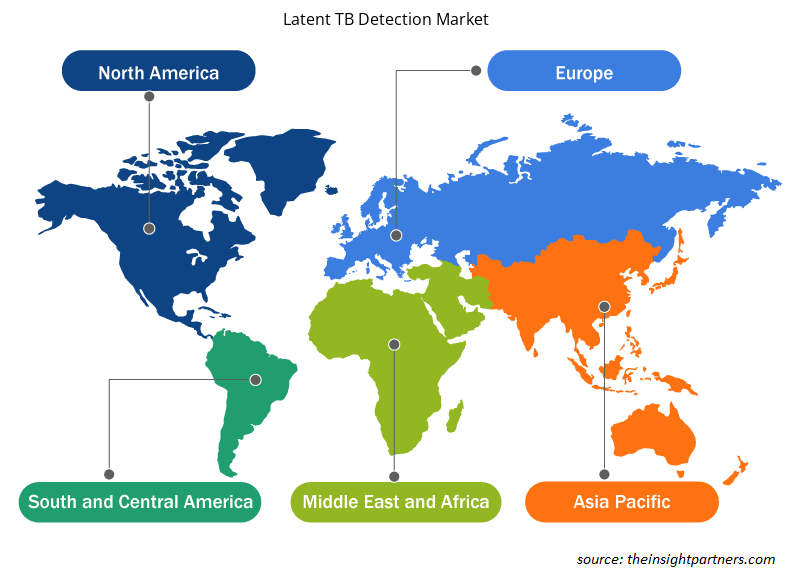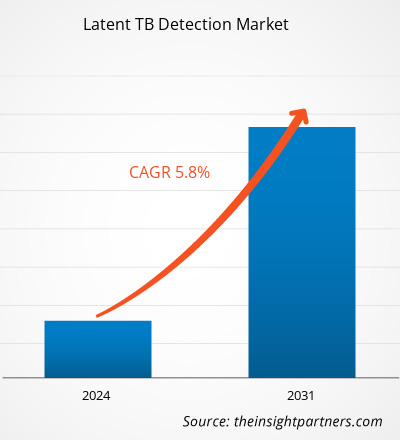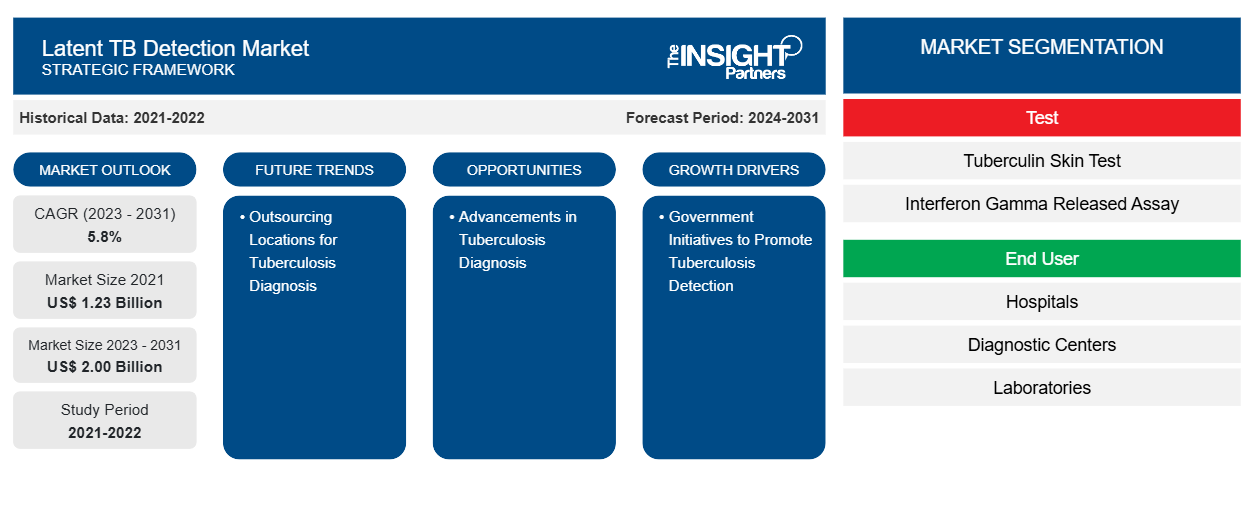Das Marktvolumen für die Erkennung latenter TB wurde auf 1,23 Milliarden US-Dollar im Jahr 2021 und XX Milliarden US-Dollar im Jahr 2023 geschätzt und soll bis 2031 2,00 Milliarden US-Dollar erreichen; für den Zeitraum 2023–2031 wird eine durchschnittliche jährliche Wachstumsrate von 5,8 % erwartet. Regierungsinitiativen zur Förderung der Tuberkuloseerkennung und Fortschritte bei der Tuberkulosediagnose sind treibende Faktoren. Die Auslagerung von Standorten für die Tuberkulosediagnose wird wahrscheinlich weiterhin ein wichtiger Markttrend für die Erkennung latenter TB bleiben.
Marktanalyse zur Erkennung latenter TB
In Ländern mit niedrigem bis mittlerem Einkommen, in denen die TB-Prävalenz hoch ist, gibt es unzureichende Gesundheitsdienste, eine begrenzte Medikamentenversorgung, unterdiagnostizierte Fälle und eine geringe Anzahl registrierter Fälle durch die Bevölkerung aufgrund fehlender Informationen, was alles zu einem Anstieg der TB-Fälle beiträgt. Weltweit erkranken schätzungsweise 10 Millionen Menschen an TB, und jährlich sterben über eine Million Menschen daran. Indien trägt mehr als 25 % zur weltweiten TB-Belastung bei, mit einer geschätzten TB-Inzidenz von 2,77 Millionen im Jahr 2022. Darüber hinaus hatte die Bevölkerung in ländlichen Gebieten laut einer Feldstudie in Indonesien nur eingeschränkte Informationen über die Ursachen und Übertragung von TB, was zu einer Stigmatisierung von TB-Patienten in der Bevölkerung führte. Daher hat das indonesische Gesundheitsministerium erklärt, dass Indonesien bis 2035 frei von TB sein muss. Darüber hinaus meldete Südostasien im Jahr 2021 fast die Hälfte der TB-Fälle weltweit, nämlich 4,82 Millionen oder 45,4 %.
Marktübersicht zur Erkennung latenter TB
Der asiatisch-pazifische Raum ist der am schnellsten wachsende Markt für die Erkennung latenter TB. Das Wachstum wird vor allem durch die zunehmende Verbreitung von TB, zunehmende staatliche Initiativen zur Ausrottung der TB-Infektion und die Einführung moderner Diagnoseprodukte vorangetrieben. Neue Testkits für latente TB , IGRA, liefern genauere Ergebnisse als Tuberkulin-Hauttests. Das Land hat das chinesische TB-Projekt zur Kontrolle von Infektions- und Endemiekrankheiten (IEDC) gestartet, um die TB-Infektion unter Kontrolle zu bringen. Das IEDC-Projekt war ein großer Erfolg. Infolgedessen sank die Zahl der TB-Patienten zwischen 1990 und 2000 um 36,1 %. Trotz der Erfolge des IEDC-Projekts gab es jedoch weiterhin Probleme mit dem TB-Kontrollprogramm in China.
Passen Sie diesen Bericht Ihren Anforderungen an
Sie erhalten kostenlos individuelle Anpassungen an jedem Bericht, einschließlich Teilen dieses Berichts oder einer Analyse auf Länderebene, eines Excel-Datenpakets sowie tolle Angebote und Rabatte für Start-ups und Universitäten.
-
Holen Sie sich die wichtigsten Markttrends aus diesem Bericht.Dieses KOSTENLOSE Beispiel umfasst eine Datenanalyse von Markttrends bis hin zu Schätzungen und Prognosen.
Markttreiber und Chancen für die Erkennung latenter TB
Regierungsinitiativen zur Förderung der Tuberkuloseerkennung
Belege aus verschiedenen Quellen wie der Weltgesundheitsorganisation (WHO) und den Vereinten Nationen (UN) zeigen, dass Länder wie Indien und Indonesien im asiatisch-pazifischen Raum von TB-Patienten überlaufen sind. Daher ergreifen die Regierungen dieser Länder bestimmte Programme und Initiativen, um die Krankheit einzudämmen. So wurde beispielsweise der indische Nationale Strategische Plan (NSP), der die Ausrottung von TB zum Ziel hat, von 2017 bis 2025 ins Leben gerufen; er sieht mehrere Selbsthilfegruppen, Schutzmaßnahmen, kostenlose TB-Diagnosetests und Behandlungen für Inder vor. Darüber hinaus veröffentlichten die Centers for Disease Control and Prevention (CDC) und die National Tuberculosis Controllers Association (NTCA) im Mai 2019 aktualisierte Empfehlungen zur Häufigkeit von TB-Screenings, -Tests und -Behandlungen für medizinisches Personal.
Fortschritte in der Tuberkulosediagnostik – eine Chance
Hersteller und Forscher arbeiten kontinuierlich daran, neue und praktikable Lösungen auf der Grundlage leistungsfähiger Technologien zu finden, um TB genau zu diagnostizieren. So haben Cepheid, Inc. und The Foundation for Innovative New Diagnostics (FIND) im Juli 2020 gemeinsam einen neuen Profiltest für medikamentenresistente Tuberkulose entwickelt, der Ergebnisse in 90 Minuten liefert. Darüber hinaus hat die Verfügbarkeit blutbasierter Diagnostik in Interferon-γ-Release-Assays (IGRAs) Kliniker entlastet, da sie nun zuverlässige Testergebnisse zum Nachweis einer latenten TB-Infektion mit hoher Spezifität und Sensitivität liefern können. Neuere Testkits für latente TB, Interferon-Gamma-Release-Assays (IGRAs), liefern genauere Ergebnisse als der jahrhundertealte Tuberkulin-Hauttest.
Die Anwendung der Diagnose zur Erkennung latenter Tuberkulose hat in verschiedenen Ländern Nordamerikas, Europas und Asiens deutlich zugenommen.
Marktbericht zur Erkennung latenter TB – Segmentierungsanalyse
Wichtige Segmente, die zur Ableitung der Marktanalyse zur Erkennung latenter Tuberkulose beigetragen haben, sind Produkttyp, Portabilität, Behandlungstyp, Anwendung und Endbenutzer.
- Basierend auf dem Test ist der Markt für die Erkennung latenter TB in Tuberkulin-Hauttest (TST) und Interferon-verwandten Gammatest (IGRA) segmentiert. Das Segment Interferon-verwandter Gammatest (IGRA) hielt im Jahr 2023 den größten Marktanteil. Außerdem wird geschätzt, dass das ähnliche Segment im Prognosezeitraum die höchste durchschnittliche jährliche Wachstumsrate auf dem Markt verzeichnet.
- Basierend auf den Endverbrauchern ist der Markt für die Erkennung latenter TB in Krankenhäuser, Diagnosezentren, Labore und andere unterteilt. Das Krankenhaussegment hielt im Jahr 2023 den größten Marktanteil. Darüber hinaus wird geschätzt, dass dasselbe Segment im Prognosezeitraum die höchste durchschnittliche jährliche Wachstumsrate (CAGR) auf dem Markt verzeichnet.
Marktanteilsanalyse zur Erkennung latenter TB nach Geografie
Der geografische Umfang des Marktberichts zur latenten TB-Erkennung ist hauptsächlich in fünf Regionen unterteilt: Nordamerika, Asien-Pazifik, Europa, Naher Osten und Afrika sowie Südamerika/Süd- und Mittelamerika.
Der Markt für latente Tuberkuloseerkennung wird in den kommenden Jahren voraussichtlich im asiatisch-pazifischen Raum die höchste durchschnittliche jährliche Wachstumsrate aufweisen. Das Wachstum im asiatisch-pazifischen Raum ist durch steigende Tuberkulosefälle und zunehmende staatliche Initiativen gekennzeichnet. Nach Schätzung der Weltgesundheitsorganisation ist ein Viertel der Weltbevölkerung an Mycobacterium tuberculosis erkrankt, und 5 bis 10 Prozent der Infizierten entwickeln eine aktive Tuberkulose. Davon leben 27 % der weltweiten Tuberkulosepatienten in Indien. Daher werden Initiativen ergriffen. So wurde beispielsweise im Rahmen des National Tuberculosis Elimination Programme der Cy-TB-Test auf der Ni-kshay-Plattform eingeführt. Dies stellt einen großen Fortschritt bei der Tuberkulosebekämpfung im Land dar.
Regionale Einblicke in den Markt für latente TB-Erkennung
Die regionalen Trends und Faktoren, die den Markt für latente TB-Erkennung im Prognosezeitraum beeinflussen, wurden von den Analysten von Insight Partners ausführlich erläutert. In diesem Abschnitt werden auch Marktsegmente und Geografie für latente TB-Erkennung in Nordamerika, Europa, im asiatisch-pazifischen Raum, im Nahen Osten und Afrika sowie in Süd- und Mittelamerika erörtert.

- Erhalten Sie regionale Daten zum Markt für die Erkennung latenter TB
Umfang des Marktberichts zur latenten TB-Erkennung
| Berichtsattribut | Details |
|---|---|
| Marktgröße im Jahr 2021 | 1,23 Milliarden US-Dollar |
| Marktgröße bis 2031 | 2,00 Milliarden US-Dollar |
| Globale CAGR (2023 - 2031) | 5,8 % |
| Historische Daten | 2021-2022 |
| Prognosezeitraum | 2024–2031 |
| Abgedeckte Segmente |
Durch Test
|
| Abgedeckte Regionen und Länder |
Nordamerika
|
| Marktführer und wichtige Unternehmensprofile |
|
Dichte der Marktteilnehmer zur Erkennung latenter TB: Auswirkungen auf die Geschäftsdynamik verstehen
Der Markt für die Erkennung latenter TB wächst rasant, angetrieben durch die steigende Nachfrage der Endnutzer aufgrund von Faktoren wie sich entwickelnden Verbraucherpräferenzen, technologischen Fortschritten und einem größeren Bewusstsein für die Vorteile des Produkts. Mit steigender Nachfrage erweitern Unternehmen ihr Angebot, entwickeln Innovationen, um die Bedürfnisse der Verbraucher zu erfüllen, und nutzen neue Trends, was das Marktwachstum weiter ankurbelt.
Die Marktteilnehmerdichte bezieht sich auf die Verteilung der Firmen oder Unternehmen, die in einem bestimmten Markt oder einer bestimmten Branche tätig sind. Sie gibt an, wie viele Wettbewerber (Marktteilnehmer) in einem bestimmten Marktraum im Verhältnis zu seiner Größe oder seinem gesamten Marktwert präsent sind.
Die wichtigsten Unternehmen auf dem Markt für die Erkennung latenter Tuberkulose sind:
- QIAGEN
- BioMeriux SA
- F. Hoffmann La-Roche Ltd.
- BD
- ARKRAY, Inc.
- Abbott
Haftungsausschluss : Die oben aufgeführten Unternehmen sind nicht in einer bestimmten Reihenfolge aufgeführt.

- Überblick über die wichtigsten Akteure auf dem Markt für latente Tuberkulose-Erkennung
Neuigkeiten und aktuelle Entwicklungen zum Markt für die Erkennung latenter TB
Der Markt für die Erkennung latenter TB wird durch die Erfassung qualitativer und quantitativer Daten aus Primär- und Sekundärforschung bewertet, die wichtige Unternehmensveröffentlichungen, Verbandsdaten und Datenbanken umfasst. Im Folgenden finden Sie eine Liste der Entwicklungen auf dem Markt für die Erkennung latenter TB:
- Das Serum Institute of India (SII) und Mylab Discovery Solutions haben einen Point-of-Care-Hauttest zum Nachweis latenter Tuberkulose-Infektionen (LTBI) auf den Markt gebracht. Der Preis soll nach Angaben der Unternehmen 50 bis 70 Prozent niedriger sein als bei vergleichbaren Tests auf dem Markt. Durch verschiedene Maßnahmen arbeitet diese Partnerschaft an der Diagnose, Behandlung und Prävention von Tuberkulose. (Quelle: Serum Institute of India (SII)/Pressemitteilung, Oktober 2023)
- Mylab bringt ein Kit zum Nachweis von TB und einer multiresistenten Variante in einem einzigen Test auf den Markt. Das Kit trägt den Namen PathoDetect MTB RIF and INH Drug Resistance Kit. Dieses RT-PCR-basierte Kit zur genauen Erkennung wird mit Mylab Compact-Gerätesystemen verwendet, die das automatisierte Testen mehrerer Proben innerhalb von zwei Stunden ermöglichen. (Quelle: Reveal Lasers, Pressemitteilung, Oktober 2023)
Marktbericht zur Erkennung latenter TB: Umfang und Ergebnisse
Der Bericht „Marktgröße und Prognose zur Erkennung latenter TB (2021–2031)“ bietet eine detaillierte Analyse des Marktes, die die folgenden Bereiche abdeckt:
- Marktgröße und Prognose auf globaler, regionaler und Länderebene für alle wichtigen Marktsegmente, die im Rahmen des Projekts abgedeckt sind
- Marktdynamik wie Treiber, Beschränkungen und wichtige Chancen
- Wichtige Zukunftstrends
- Detaillierte PEST/Porters Five Forces- und SWOT-Analyse
- Globale und regionale Marktanalyse mit wichtigen Markttrends, wichtigen Akteuren, Vorschriften und aktuellen Marktentwicklungen
- Branchenlandschaft und Wettbewerbsanalyse, einschließlich Marktkonzentration, Heatmap-Analyse, prominenten Akteuren und aktuellen Entwicklungen
- Detaillierte Firmenprofile
- Historische Analyse (2 Jahre), Basisjahr, Prognose (7 Jahre) mit CAGR
- PEST- und SWOT-Analyse
- Marktgröße Wert/Volumen – Global, Regional, Land
- Branchen- und Wettbewerbslandschaft
- Excel-Datensatz
Aktuelle Berichte
Erfahrungsberichte
Grund zum Kauf
- Fundierte Entscheidungsfindung
- Marktdynamik verstehen
- Wettbewerbsanalyse
- Kundeneinblicke
- Marktprognosen
- Risikominimierung
- Strategische Planung
- Investitionsbegründung
- Identifizierung neuer Märkte
- Verbesserung von Marketingstrategien
- Steigerung der Betriebseffizienz
- Anpassung an regulatorische Trends























 Kostenlose Probe anfordern für - Markt für die Erkennung latenter TB
Kostenlose Probe anfordern für - Markt für die Erkennung latenter TB